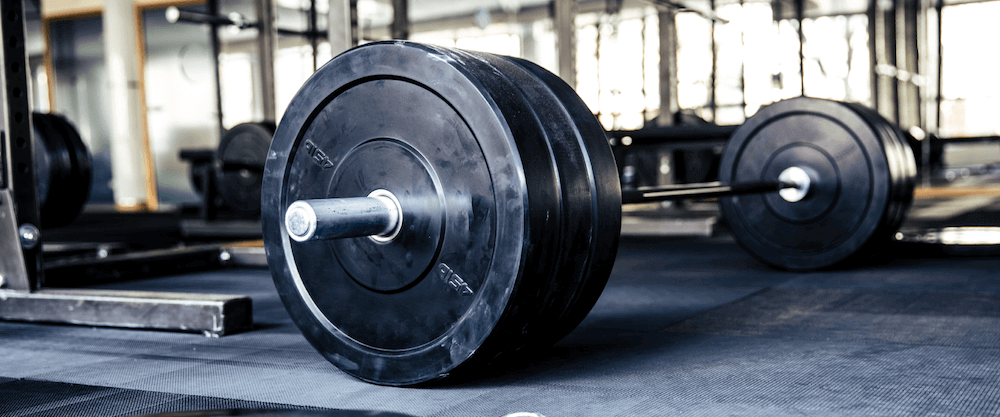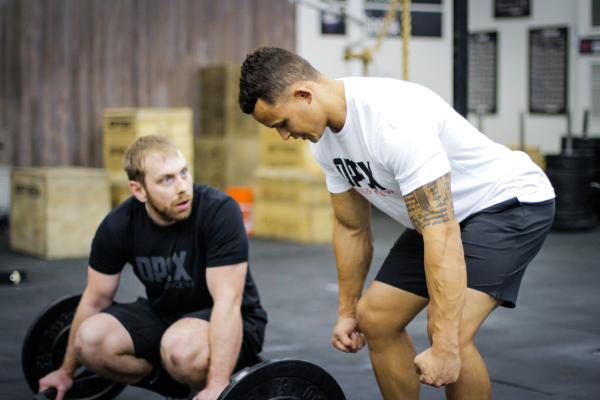Why Strength Training Improves Looks, Health, & Performance
If you lift weights, you likely want to build muscle, increase your strength or improve your health. Strength training can lead to all three outcomes. I have an outcome-biased perspective on health and fitness as a whole. By this, I mean I always ask myself, “Why?” when determining if something is good or bad, right or wrong, smart or dumb. With this perspective, I’m going to dig into the three biggest reasons people lift weights…to get bigger, stronger or generally healthier. To do this, I’ll share a closer look at the mechanisms of strength training and how these mechanisms correlate with these three major goals.
Read the full article on Athletech News here.
How To Instill Good Health & Fitness Habits in Kids
Instilling healthy habits in kids can seem like an overwhelming task but as coaches or parents, we have a responsibility to educate children. A lot of coaches freeze up when asked the question, “What are good health and fitness habits for my kids?” It can be a bit intimidating to step into the world of youth health as most of the recommendations and information out there are built around creating better youth athletes and not so much on how to set them up to be healthy adults. Addressing nutrition, especially for children, is a sensitive and crucial conversation. It’s pivotal for us, as fitness coaches, to guide our clients and their children in establishing and maintaining a wholesome, balanced lifestyle from early on.
In this piece, I will lay out a few general principles for coaches to consider when working with youth or giving their clients with kids advice on how to approach health and fitness with their own kids.
Read the full article on Athletech News here.
How To Program Strength Training for the Average Gym Client
As fitness coaches, we frequently fall into the trap of applying high-level, performance-oriented principles universally to all clients, regardless of their individual needs, goals or abilities. If you think about it, it’s actually quite silly. Why are we using percentage-based deadlift programs with 55-year-old Betty, who just wants to slow down the arthritis she’s been dealing with? And why program drop-clusters with a sprinkle of back-off sets for 35-year-old, new father, Dan, who is looking to exercise for the first time since college to be a good example for his son?
A better approach is required for the majority of our clients, folks who fall into the general population and are seeking improved health and vitality for longevity.
In this article, I want to offer up a few principles to consider when designing resistance training programs for general population individuals whose primary goals revolve around enhancing overall well-being and longevity.
Read the full article on Athletech News here.
How To Get More Clients as a Fitness Coach
If you’re a fitness coach who wants more clients, casting too wide a net is a recipe for failure. Instead, start by asking, “Who do I want to coach?” In the seemingly “evolving” landscape of the fitness industry, having a targeted approach to identifying your ideal clients is still a huge key to success. The process of identifying your ideal client involves more than recognizing who you simply want to serve; it’s about aligning services, communication and value proposition with the needs of your prospective clients. In this piece, I will discuss a few principles fitness coaches can use to pinpoint ideal clients.
Read the full article on Athletech News here.
How Fitness Coaches Should Use AI for Program Design
Your ability to use AI to write training programs rests on how well you can speak its language. Follow these principles to craft effective prompts. Artificial Intelligence (AI) has become a popular tool in a ton of industries across the world over the last year or so. In a previous exploration of AI in coaching, we dove into how AI intersects with fitness coaching and discussed how it could be perceived not as a threat but as a beneficial in our coaching practices.
Today, let’s go a bit deeper, focusing on the practical utilization of ChatGPT in designing training programs, using the build of a 5k row progression as a case study.
Read the full article on Athletech News here.
The Power of Consistency as a Fitness Coach
The world is in a constant search for quick fixes and rapid transformations. As professional coaches, we must preach the power of consistency. I often ask myself what truly sets apart an exceptional coach from the rest. There are a ton of attributes that come to mind, such as competence, confidence, humility and trustworthiness, but it’s more than just these things. While these traits matter, they lose their effectiveness if not applied consistently.
Read the full article on Athletech News here.
Maximize Your Program Design Productivity as a Fitness Coach
To increase program design efficiency, you must take a 360-degree approach to assess efficiency blockers in your daily life. Productivity is often seen as a straightforward measure of output. For fitness coaches, this could mean the number of clients they handle, the programs they design, communication with clients or the results they achieve. However, enhancing productivity isn’t just about doing more in less time. It’s about recognizing both overt and subtle factors that influence one’s efficiency.
Read the full article on Athletech News here.
How To Recession-Proof Your Fitness Coaching Practice
None of us are immune to the economic climate, so it’s essential that fitness coaches take a proactive approach to building a resilient practice. In today’s ever-evolving economic landscape, fitness coaching professionals, particularly in the United States, must be proactive and prepared for downturns. One such downturn is the dreaded recession. We’ve been anticipating and expecting an official recession in the U.S. for some time now, and this got us thinking, “What should coaches do to make it through this challenging economic time?”
Read the full article on Athletech News here.
The Pros & Cons of Evidence-Based Fitness Coaching
Should we accept scientific research as immutable law or throw away capital T truths altogether? I propose a more nuanced approach. Evidence-based coaching has significantly shifted the direction of fitness over the past few decades. With evidence-based pioneers like Charles Poliquin in individualization, Paul Chek with his holistic, 360-degree approach, and James Fitzgerald breaking through to build new ways of thinking in CrossFit, an area where there was no evidence, the evidence-based approach has deeply embedded itself into fitness coaching practices.
Read the full article on Athletech News here.
How To Build Stronger Coach-Client Relationships
If you want to help your clients improve their health, performance and vitality, start focusing on developing meaningful relationships. As fitness coaches, our role extends beyond designing training programs and nutrition plans. Our impact hinges on the relationships we cultivate with our clients. In this article, I will dig deeper into this concept and offer a few helpful frameworks for you to build these relationships.
Read the full article on Athletech News here.
How To Assess Your Clients
Here’s a four-part assessment system every fitness coach can use to set each client up for success. “Assess…don’t guess” – Paul Chek.
These words, originating from Paul Chek and drilled into me by my mentor James Fitzgerald, serve as a guiding principle in effective fitness coaching. The statement highlights the need for assessing our clients, and not generalized guesswork, in achieving desired fitness outcomes.
Read the full article on Athletech News here.
Implementing Individual Design in a Group Gym
Can I incorporate individual design coaching into my group fitness gym? Yes, but it’s important to consider the pros and cons of a hybrid model. In my previous article, we discussed the distinct advantages and potential challenges associated with both individual design and group coaching models. As a company deeply rooted in one-on-one coaching, at OPEX, we frequently get asked the question: “How can I incorporate an Individual Design service into my group-oriented gym?”
Read the full article on Athletech News here.
Use Tough Aerobic Work To Improve Vitality
Tough aerobic work isn’t for the faint-hearted, but it can lead to profound health and fitness benefits that last a lifetime. We are now at our third, and final, characteristic that should be included in every training program, and we advance to the upper limits of aerobic training: tough aerobic work. In our previous articles, we discussed the fundamentals of resistance training and easy aerobic work, setting the foundation for overall health and fitness. Now, we will explore the challenging, yet rewarding, world of tough aerobic training.
Read the full article on Athletech News here.
Why Easy Aerobic Work Is Essential
Love it or hate it, easy aerobic work, or cardio, is essential for health and longevity. Here’s a progressive approach to programming it. The human body is a complex system that thrives on movement. As we’ve explored in our previous post on resistance training, maintaining physical strength is crucial, especially as we age. However, strength is only one facet of our overall fitness. The underpinning of all movement and a critical component of our health and fitness is aerobic work.
Read the full article on Athletech News here.
Resistance Training To Maintain Strength & Longevity
We lose 30% of our muscle mass by age 80. To offset that, incorporate this simple approach to resistance training in every program you design. As the natural progression of aging sets in, our muscle mass and physical activity levels begin to decline. By the time we reach 80, we are left with about 30% less muscle than at our peak, and we lose muscle strength two to three times more quickly than muscle mass. Maintaining our physical strength becomes crucial, and that’s where resistance training comes into play.
Read the full article on Athletech News here.
Group Coaching vs Individual Design
The debate between individual design and group coaching is a heated one. Here’s why I’ve hung my hat on individual design. The debate between individual design and group coaching is a long-standing one in the fitness industry. For the last decade or so, I’ve chosen the individual design approach after years of running gyms that were group-centric and fell short of what I deemed to be success for my clients and coaches. This does not mean there is only one way, and it does not mean that anything but individual design is trash, but based on my experience, my biases and what I believe to be success in this industry, it is the best model for coaches and clients.
Read the full article on Athletech News here.
3 Exercise Types Everyone Needs To Live Longer
Exercise is one of the most powerful tools to support vitality and longevity, but certain types of training are most beneficial for long-term health. As we grow older, it becomes increasingly important to maintain our physical health. However, the aging process brings with it a natural decline in muscle mass and capacity due to a decrease in physical activity. Knowing this, an effective training program becomes imperative in mitigating the adverse effects of aging.
Read the full article on Athletech News here.
Pattern-Based Program Design
Rather than designing programs around specific muscle groups, try taking a pattern-based approach to training splits. Instead of the traditional approach of targeting specific muscle groups, at OPEX, we believe in the efficacy of a pattern-based approach. So, why should we use patterns, how do we assess them and how do we implement this concept into program design? I want to discuss these questions in this article.
Read the full article on Athletech News here.
How Fitness Coaches Can Leverage AI
The rise of AI has spurred apprehension among fitness coaches, but these perceived threats can be turned into opportunities. More and more, we’re seeing AI technologies infiltrating just about all industries. I remember back in 2018-2019, the talk was all about AI taking over blue-collar jobs like factory workers, truck drivers, etc. Now, we’re seeing AI technologies being built that are becoming a major threat to white-collar workers such as attorneys, copywriters, and customer support staff. If I were one of those white-collar workers, I’d ask myself, “How can I leverage this technology to make me more efficient and effective at my job?”
Read the full article on Athletech News here.
Overcome These Program Design Mistakes
Here are four common program design mistakes coaches make, so you don’t have to make them yourself. As a coach, you know that creating effective programs will help your clients reach their fitness goals. However, it’s essential to recognize the significance of your client’s capabilities and your intention behind the training program. In this article, I will discuss a systematic approach to understanding your client’s capabilities and intentions, enabling you to create tailored exercise programs that maximize results.
Read the full article on Athletech News here.
Simplifying Energy System Training
This principle-based framework for conditioning will help you design effective progressions for the aerobic and anaerobic energy systems. As a coach, one of your primary responsibilities is to design effective training programs that help your clients achieve their goals. When it comes to energy system training, however, things can get a bit complicated. With so many methods of incorporating metabolic conditioning, it can be challenging to create a training program that targets each system effectively without overwhelming your coaching brain.
Read the full article on Athletech News here.
How To Turn Your Passion Into a Paycheck
Being a professional coach requires more than an understanding of fitness knowledge, yet hopeful career coaches often overlook these key areas. If you consider yourself a professional fitness coach, it’s important to understand the definition of a professional. According to the dictionary, a professional is someone engaged in a specified activity as their main paid occupation rather than as a pastime.
Read the full article on Athletech News here.
The Best Way To Increase Aerobic Capacity
Is it better to go long and slow or short and fast to increase aerobic capacity? Here’s a simple framework you can follow. There are a lot of varying thoughts out there on how we should approach aerobic training to improve our aerobic capacity. Opinions are split between specific zones, aerobic implements, work-rest ratios, long and slow advocates, short and fast advocates, and more. In this article, I want to make the case that they’re all right and we should take something from each camp to build an aerobic system that will last.
Read the full article on Athletech News here.
Basic Lifestyle Guidelines – The Foundation
You can’t build sustainable change on a shaky foundation. These 8 lifestyle habits are an essential base that will set you up for a lifetime of health and fitness. At OPEX, we’ve taught our coaches for years that we can’t build upon a shaky foundation and that a solid foundation consists of doing the simple things first. When it comes to fitness and wellness, many people focus on finding the perfect program or diet to achieve their goals. But before jumping into a complicated regimen, it’s essential to first establish a strong foundation of healthy habits. That’s where Basic Lifestyle Guidelines (BLGs) come in. BLGs are simple, natural, holistic, intuitive, biologically sound, impactful, foundational and revealing guidelines that form the basis of a healthy lifestyle. They are like tempo in exercise—you don’t have to track them, but if you ignore them, you risk building a shaky foundation.
Read the full article on Athletech News here.
Wearable Tech – Use It To Lose It
Whether it’s tracking sleep, steps, heart rate or HRV, the ultimate goal of leveraging fitness wearables should be to eventually break up with them. I’ve tested numerous wearables and have had both positive and negative experiences with them. While wearable technology can be a valuable tool for coaches, it’s important to strike a balance and use it in a way that benefits our clients without hindering their ability to self-regulate. In this article, we’ll discuss the benefits and drawbacks of wearable technology, including step counting, sleep tracking, heart rate monitoring and heart rate variability (HRV) tracking.
Read the full article on Athletech News here.
Masculine vs Feminine Program Design
Regardless of sex, we all have a unique blend of male/female or ying/yang traits that coaches should take into consideration in order to personalize and optimize program design. As coaches, we’re always on the hunt for ways to better personalize our approach and connect with our clients on a deeper level. Understanding where someone sits on the behavior spectrum can be another tool in our coaching toolbox to offer a more valuable service and a more personalized program design. Regardless of sex, we all possess a unique blend of masculine and feminine traits. In this article, I’ll explore how you can leverage these traits to create a coaching experience tailored to your client’s needs, as well as share some tips on how to identify where they sit on the behavior spectrum.
Read the full article on Athletech News here.
Go Beyond Sets & Reps
To avoid being made obsolete by AI tools like ChatGPT, fitness coaches must take a holistic approach and seek to understand the whole person. As coaches, it’s easy to get caught up in the sets and reps and forget about the most important aspect of our work: building relationships with our clients.
Read the full article on Athletech News here.
One-on-One With Carl Hardwick, CEO of OPEX Fitness

















